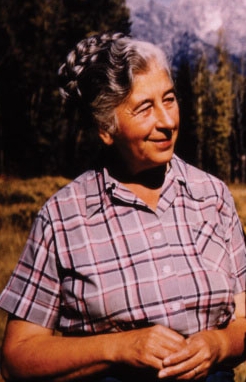Nature was preserved by a female naturalist

English, Edith; U.S. Fish and Wildlife Service (crop by Sven Manguard), Public domain, via Wikimedia Commons
April 2, 2022
Usually, when Women’s History Month rolls around, people talk about modern-day, living women who should be honored or very well-known women in history who should be remembered.
While this is important, it is also essential to honor accomplished women who are less known by the general public. One such person is Margaret Thomas Murie, who is widely considered the “grandmother of the conservation movement.”
Murie spent much of her life working on the conservation of natural lands and species in the wild. She had a big hand in the passing of the U.S. Wilderness Act in 1963, which created the National Wilderness Preservation System and preventedlands from being developed.
Murie, who went by Mardy with her friends and family, was born on Aug. 18, 1902, in Seattle, Washington. When she was young, her family moved to Fairbanks, Alaska, which is where her love of the natural world developed.
Even before her career began, Murie was setting records; she was the first woman to graduate from the Alaska Agricultural College and School of Mines, now the University of Alaska, Fairbanks.
In that same year, she married her lifelong husband, Olaus Murie. He was working for the U.S. Fish and Wildlife Service, which was then called the U.S. Bureau of Biological Survey.
After getting married, the two went on an eight-month-long expedition for Olaus’s job to Brooks Range, Alaska, to study caribou, which they referred to as their honeymoon.
Murie took detailed notes of all of Olaus’s specimens and she became increasingly concerned with conservation.
The couple did talks, wrote articles, penned letters and vocalized support for legislation to protect and conserve the country’s remaining wildlands.
Their persistence paid off when in 1960 the Arctic National Wildlife Range was established. Another big win came in 1964 when the Wilderness Act was signed into law, which Murie had long advocated for.
In 1975, she was appointed to a task force that recommended which areas of Alaska needed environmental protection.
She also had a hand in the Alaska National Interest Lands Conservation Act, which was passed in 1980, that protected more than 100 million acres of land. This act expanded the area protected by the 1960 Arctic National Wildlife Range and renamed it the Arctic National Wildlife Refuge.
Murie was awarded the Audubon Medal for her devotion to conservation in 1980 and the Presidential Medal of Freedom by former President Bill Clinton in 1998.
While she might not be a household name, Murie’s advocacy on the conservation of wildland and wildlife helped change the country forever.







